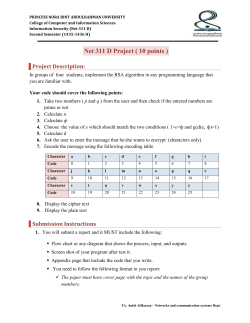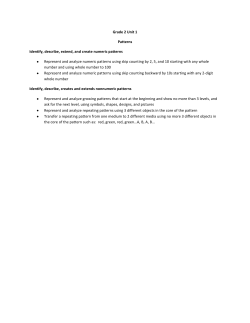
Mathematics Activities for Out of Class
Mathematics Activities for Out of Class Suggested activities to be done at home with an adult The National Numeracy Strategy in Cumbria This booklet is a compilation of ideas from schools It can be used in conjunction with the LEA Homework Guidelines produced by the Advisory Teacher Team. The Cumbria Numeracy Team looking at prices calculating change - which coins, different combinations deciding on coins to pay a bill guessing the value of a coin from a description weighing fruit and vegetables in the supermarket counting pocket money calculating the price of a holiday from brochures reading labels on bottles, packets, in order to discuss capacity, weight, shape, colour estimating the final bill at the end of shopping while waiting at the cash out calculating VAT, calculating foreign currency exchange rates purchasing litres of petrol and calculating total cost calculating discounts eg 20% reduction, 50% sale price calculating how many tins fill an area on a shelf using shopping bills to calculate many apples, change estimating how tomatoes in a pound calculating bank accounts and rates of interest calculating postage on letters using first or second class stamps writing and sorting shopping lists rubbings of different coins – can we recognise the value? talking about the different shapes of packets, tins etc. calculating the cost of a meal using a menu compare the prices of the same item in different shops using a collection of receipts as a basis for addition, etc calculating the cost of the contents of a lunch box using a scanner in a supermarket using the till receipt to check the shopping calculating price per pound, kilogram, etc Calculating the cost of the family going to the cinema, swimming baths, etc Talk about numbers!! looking at the clock - identify the numbers telling the time calculating how long a journey will take looking at train/bus/airline timetables using TV guide to calculate the length of programmes programming the video, the microwave discussing the seasons looking at a calendar - days, weeks, months planning out birthdays and discussing how many weeks estimating how long it will take to walk/drive to school identifying the day of the week on a newspaper calculating time differences in foreign countries calculating the age given a date, eg I was born in 1954, how old am I? The building was built in 1860, how old is it? discussing the age of family members, putting them in order calculating the time if the clock is 10 minutes fast, 10 minutes slow trying to find a clock in every shop on a visit to town looking at the posting times on the post box discussing events in the day eg tea time, bed time, bath time setting the radio alarm standing still for a minute – count 60 seconds looking at different types of clocks looking at the headstones in a graveyard to calculate ages, etc using Teletext on TV Vocabulary of time – decade, century, millennium using clocks - analogue and digital Think about numbers!! the main events of the day eg breakfast, lunch routines and what comes next the parts of a recipe, set of instructions getting dressed tying shoe laces the seasons of the year, months of the year organising a sponsored event the instructions to make a cup of tea tying laces What comes next? calculating distances in a journey eg how much further? How many miles to the litre? calculating heights of family members - who is the tallest? measuring weights of ingredients for baking playing with plastic jugs and containers in the bath measuring a distance using hand spans, footsteps reading a map to calculate the distance of a journey using non-standard measures to decide a measurement comparing sizes of clothes - bigger than, smaller than calculating areas eg how many squares on the patio, how many tiles in the shower? calculating in DIY activities eg estimate amount of carpet, curtain material, paint etc looking at bottles and discussing capacity of various containers recording the growth of plants in the garden estimating the length of the holiday journey drawing simple plans of the bedroom, the kitchen, the garden looking at road signs to discuss distances comparing the shoe sizes within the family identifying position on an OS map using co-ordinates and grid references calculating capacity of coke can, milk cartons, etc reading the scale on weighing machines and calculating the calibrations measuring ingredients out for a recipe using different types of spoons comparing journey distances using different routes calculating the capacity of the bath using a variety of containers converting miles to kilometres on a car journey discussing oven temperature when cooking monthly diary of own weight, height, etc matching metric weight of article to that on the label using different length measuring devices eg rulers, tape measures weighing different toys to find heaviest, lightest, two the same, etc talking about thermostats in the home water consumption/wastage in the home measuring the growth of plants using nonstandard measures estimating the quantity of milk from cow/herd estimating the amount of time to harvest a field making orange squash – how many cups can you get from one bottle? weighing unusual items eg snails discussing the weight of your pet at the vets estimating with string the circumference, perimeter of a puddle made by pouring 1 pint of water on the ground estimating then counting the squares contained in the outline of a hand/foot making clothes for toys to scale wrapping parcels - what amount of paper, string do we need? Numbers are fun!! 1. 2. 3. 4. 5. 6. 7. 8. 9. 10. 11. 12. 13. 14. 15. 16. 17. 18. 19. 20. collections of objects - shells, buttons, pretty stones cars on a journey eg how many red cars? animals in a field eg sheep, cows stairs up to bed, steps etc stepping stones in the garden railings around the school, park, garden lamp posts, gates, road signs house numbers but emphasising odd and even sports scores - cricket averages, goal averages pages in a story book traffic to pass a house and draw graphs, pie charts to represent data counting up to 10, 20, 100 – backwards and forwards counting buttons, shoes, socks as a child gets dressed tidy a cupboard or shelf and count the contents eg tins, shoes, etc rows of seeds in the garden and plants in pots etc counting particular vehicles on a journey eg Eddie Stobart lorries, motor bikes, etc using magnetic numbers to make sums on the fridge door counting the legs on pub signs eg Duke of York, The Horse and Farrier tally charts eg bird survey on a bus journey count how many people on the bus, how many get off, etc Have fun with numbers!! ♦ using car number plates - add the digits to find biggest, smallest and total ♦ sharing out sweets, toys etc in groups of 2, 3, 4, 5, 6 etc to help with times tables ♦ looking for numbers - in shops, on buses, doors, cars ♦ using telephone numbers - add the digits to find the nearest to 20, 30 etc ♦ using telephone numbers - value of each digit ♦ using sandwiches to show fractions 1/2, 1/4 ♦ using a round sandwich cake to show fractions 1/2, 1/4, 1/6, 1/8 etc ♦ looking at house numbers along the street ♦ looking in newspapers at sports results – calculate average scores, average crowds, etc ♦ looking at speed limits on a journey ♦ finding ‘big’ numbers in newspapers ♦ pressing the digits on the telephone to make a call with an adult ♦ looking for numbers in the home eg washing machine, thermometer, cooker ♦ checking the temperature in different parts of the world in a newspaper ♦ calculating the age of a car, wagon, coach from the number plate ♦ on a visit to town – can you find a number 5, 6, etc? ♦ collecting data and representing in pictorial form eg graph, pie chart ♦ reading meters eg electricity, gas ♦ using TV weather forecast to discuss temperature, wind speed, wind direction, etc ♦ folding towels to show ½, ¼ ♦ calculating the number of twin lambs born ♦ using the appropriate vocabulary eg position – on, over, up, down, above, below ♦ keeping a height chart in the kitchen/bedroom Numbers pop up everywhere!! laying the table for four people planning a TV viewing session planning a day out for the family asking what do you think will happen if ……? How did numbers help you? In relation to planning: school visits menus school teams sports day family day out to a theme park family day out to the shops You need your numbers to help in solving problems singing nursery rhymes and songs clapping in different sequences reading stories with a number element games of chance calculator fun games looking for shapes in the environment eg windows looking for and making patterns eg bricks in a wall, square tiles on a floor playing with a number line or number square using a thermometer to read temperature - identify negative numbers identifying angles eg right angles looking at symmetry eg petals on a flower making 3D shapes in card tessellating shapes eg tiles in the bathroom grabbing straws – estimating a group of 10, 12, 15, etc counting how many items will fit into a match box or film canister using fridge magnet numbers and sponge numbers around the house making a 50cm string circle – how many items will fit in it? make a scrap book of numbers learning times tables - tape on a car journey using cross stitch and mosaics - shape, counting and symmetry making sandcastles and discussing different shapes using salt dough, plasticine to make numbers using a compass when on a walk to check direction, degrees, angles Numbers are just everywhere!! • Skipping - every skip count, 2, 3, 4 etc • Hop scotch • Ludo • Snakes & Ladders • Dominoes • Cards - number sequences • Bingo • Dice • Yahtzee • Darts • Heads & Tails and keep a tally • Chess and draughts • Monopoly • Computer programmes • Beetle • Bridge • Snap • Connect 4 • Counting games to practise times tables • I spy a number in town, on a journey • Number jigsaws • Rummy • Patience • Clock golf, croquet, crazy golf on holiday to help counting • Snooker • Pool • Number Lotto • Dot to dot with numbers • Skittles • Polydron • Happy families • Whist • Shuttle table • Quoits • Newmarket • Pontoon • Cribbage • Number crosswords, dot to dot, puzzles • Rubik cube Play games – enjoy numbers!! ♦ setting the table - 1 to 1 correspondence and sorting cutlery ♦ sorting buttons, beads, colours of pegs, sweets, biscuits, containers, seeds for the garden, flowers ♦ sorting clothes for washing size, colour ♦ matching pairs of socks, gloves, shoes ♦ ordering a group of items by size ♦ threading beads on a string to a set pattern ♦ sorting groceries Sort numbers – match numbers!!
© Copyright 2025









